Mazda CX-8 review and buyer’s guide
Australia’s SUV market is overcrowded, just like Mazda’s SUV line-up these days. So why does CX-8 exist? It makes a value proposition, but is not perfect. So why this seven-seater is worth your time and money?
There’s no denying that SUVs are the most popular new car category in Australia, and larger seven-seat versions are the ideal device for occasionally hauling your kids’ friends home after school, or dropping the oldies home after a wedding.
There are multiple disciplines for which a large SUV is the perfect option, especially those with large families and load-carrying responsibilities. So how does the Mazda CX-8 fare against its already capable stablemate, and the rest of the market?
At first introduction, the CX-8 seemed like something of a gap-filler SUV, jamming something in Mazda’s line-up between the CX-9 and CX-5 simply to compete with the likes of Mitsubishi Outlander and…that’s about it, really. It didn’t really make sense. Why would you want a slightly bigger, more expensive CX-5 capable of taking seven? Why would you want a slightly smaller CX-9 when the CX-9 is already more than good enough?
It’s also strange that Mazda would put its 2.2 diesel engine into the smaller CX-8 and not into the bigger CX-9 where that engine would be better suited to the latter’s greater bulk and larger envelope for all-in holiday haulage where half of everybody’s wardrobe (which doesn’t actually get worn) ends up being stacked to the roofline.
Whatever the reason, it gives you an interesting decision to make based on how you intend to use the vehicle. This is where most car buyers fail to make an objective purchasing decision. They buy the vehicle they ‘like’ the most, versus the one which best suits the potential user’s usage case.
Without getting hung up on the definition and semantics of this, I’m going to steer you toward the best usage case for CX-8, because that’s how things work at AutoExpert - in case this is your first time.
FEATURES & PRICING
CX-8 in front-wheel drive starts at $45,000 for the ‘Sport’ and goes up to $65,700 for the Asaki. In all-wheel drive, ‘Sport’ starts at $52,400 (that’s a massive $7K jump just to add rear-drive). The Asaki AWD is a whopping $73,000 spend before coughing up another $2700 to get the Asaki LE that gets the sexy caramel Nappa leather and captains chairs (see below). Let’s be frank here, the CX-8 is not cheap when you compare it with other mainstream rivals.
But if you’re shopping for a lower-tier luxury German SUV or maybe a Lexus, then you should consider the tens of thousands you could save buying a fully decked out CX-8 instead of a poverty pack Beemer, barge Benz or shitbox Audi.
So how do you intend to use the CX-8? Does your mob take extended roadtrips between home and some moderately far location? Do you do a lot of freeway commuting to and from work on a fairly regular basis? Are you a sales rep or some kind of frequenter of semi-rural or regional roads for vocational purposes? Maybe you run a small business which requires some occasional light towing, people moving and supplies carting between offices and clients.
If you answer yes to many, any or all of these propositions - I strongly encourage you to consider the CX-8 diesel over the CX-9 in petrol-only form. Any prudent financial decision has to be made on a long-term analytical basis here. So don’t concern yourself with short-term fuel price discrepancy between petrol and diesel, because when prices return to quasi-normal, you do not want to be stuck with the inferior powertrain that will cost you more by filling up 25-30 per cent more often.
We’ll get to that below. For now, let’s look at the practicality backbone of CX-8, because it is certainly ripped in that regard.
INTERIOR
At this point in life, you probable have one, two or three kids of varying ages. If you’re on three with the likelihood of considering a fourth, you need to immediately open another tab in your browser and start looking at the Kia Carnival: the best people mover on sale right now >>. Because that’s ultimately what you’re going to be doing with four kids - moving them around, a lot. Every trip to the airport, every school day for the next five to 10 years, every camping holiday, every sports game, every graduation, every birthday, every time they decide to have friends over for the weekend - you need the best damn tool for the job.
Put it this way, the Australian Army doesn’t use multiple small helicopters to move cargo, medical personnel and troops to provide aid and relief in some far-off disaster zone. They use a fricken Chinook. Seven-seat SUVs are compromised when it comes to all hands on deck + cargo. Because that’s their nature: you want the option of either - meaning you can’t have both.
With row three up, you can fit some gear in there, but don’t expect the full gamut of child raising megastructures to fit back there - stroller or pram, sure. Double pram, porta-cot, the shopping and Kid #2’s sports bag? Unlikely. But with row three down, absolutely it will all fit.
Interestingly, Mazda doesn’t actually say how many litres CX-8 can hold when rows two and three are collapsed
Unlike a Kia Sorento, there’s no ISOFIX points in row three of the CX-8, but there are two top tethers. But CX-8 does get third-row head-protecting curtain airbags, so anybody who does use those seats and is unfortunate enough to be involved in a serious-enough crash, will get that basic life-saving feature. This is not the case for Kia Sorento, Hyundai Santa Fe or Mitsubishi Outlander where third-row use is intermittent and infrequent. How often you are going to use row three’s seats six and seven is a factor only you can make a decision on.
Happily, unlike the Outlander’s row-three legroom bad joke, CX-8 has plenty enough for most regular size humans, on par with Santa Fe and Sorento, the CX-9 and Kluger.
CX-8 has a boot capable of inhaling 775 litres with row three down, or 209 litres with it up. But what does that mean to you in the real world? It means you need to whip out a tape measure and figure out how wide your most common high-usage boot items are, and then compare that with the boot of an actual CX-8 at the dealership.
If your budget is fully elasticised, a $75,000 pricetag will get you the top-shelf all-wheel drive CX-8 Asaki LE.
This gives you the choice of rich light brown or cream white Nappa leather seats in all three rows, plus two second-row captains chairs either side of a dual-lid centre console with cup holders.
Thing is, you have to look at this from an objective point of view, because those sultry seats and the flippy-top centre console are not exactly the best value. A penultimate CX-8 Asaki diesel wants $73,000 driveaway, which includes a 360-degree camera, cooled/ventilated seats - but the Kia Sorento GT-Line (also in diesel form) is $69,000 driveaway. Is the Mazda $4000 better? Keep reading…
MAIN COMPETITORS
Let’s take a look at exactly how the mid-size CX-5 compares with the plus-size models, starting with the wheelbase, because that gives you a guide as to how much legroom you’ll get. Then we’ll do boot space, weight and overall size.
CX-5 has a 2.7 metre wheelbase, CX-8 has 2.93 metres, which is the same as CX-9 because they’re basically the same vehicle platform underneath, just with a 107mm difference in overall body length.
But CX-5 is such a complete vehicle, thanks to offering the same 2.2 diesel engine as CX-8 - or the firecracker 2.5 turbo-petrol - without the oftentimes weight liability of an additional row three up the back. So CX-5 goes better, drive much nicer and still covers most bases when it comes to loading it up with family stuff. You literally get the same power outputs from the diesel, but a 248kg weight advantage to the five-seat CX-5.
So be sure you actually need seven seats, because not only could they sit there unused, but they will also be costing you money in fuel if they’re never utilised. In fact, it’s a five per cent difference in fuel consumption between CX-5 and CX-8 diesels, just owing to the row-three seats; that’s 5.7L/100km vs 6L/100km. Having said that, at least you’re not getting the 8.3 litres of the 2.5 turbo-petrol CX-5.
In terms of boot space, CX-5 gets 1050mm between the wheelarches, and 950mm of length from the bottom of the raked-rearward backseat, before becoming 730mm from the top of the seatback to where the tailgate will ultimately close. CX-8 on the other hand, has more. Easily over a metre along the floor to the seatback back of row two, and there’s a difference of three millimetres in space between respective sets of wheelarches - call it a draw.
Check out Measuring Cargo Volume >> to learn more about how carmaker’s size up how much you can fit into a Mazda CX-8.
And all three have the cursed surprise of a space-saver spare wheel waiting for you under the boot floor, because that’s how Mazda rolls.
Honey, I shrunk CX-9’s boot space by 5 per cent, but saved you about 10 per cent in price. You’re welcome.
The CX-s is a fairly big vehicle, but mostly in terms of is proportions relative to the driver. There’s a lot of real estate between the driver and the end of the bonnet where it meets the front nose section. And at the rear, the tailgate is rather heavy if it’s not powered in models up from the GT.
When you do get that rear bank vault door open, you get a massive cargo space - 1.27 metres of length along the floor to the bottom of the backseat. That’s impressive. Width between the wheelarches is 1.01 metres, so a difference of -4mm in favour of the CX-5.
But CX-9 holds 810 litres with row three down, where the CX-8 can still manage 775L - that’s a 5 per cent difference in cargo volume, but the CX-8 is 11 per cent cheaper (Asaki to Azami). A CX-9 GT is asking $70,000 driveaway (with fruit like the premium Bose sound system, sunroof and big 10-inch infotainment screen), while CX-8 with only five per cent less cargo volume and the same number of seats is about the same price in a top-spec Asaki - with all the toys, not just a few of them.
In layman’s terms, CX-8 is slightly less total vehicle, but a better vehicle, for a large amount less money. It’s better value.
In this critical area, I’d suggest a top-spec CX-8 is the superior value proposition over a mid-spec CX-9 or a compromised family hauler in the CX-5. Not to mention, CX-5 in its current form is not long for this world because a new version is supposed to be coming around mid-2023. The current ‘generation’ of CX-5 has been on the go since 2015 and while it’s been one of the best-selling vehicles in the country for a sizeable chunk of that time, it is aging rapidly.
I'll help you save thousands on a new Mazda CX-8 here
Just fill in this form. No more car dealership rip-offs. Greater transparency. Less stress.
ENGINE
Ignoring the uninformed dribble you’re likely to hear from the electric vehicle elite and brainwashed, diesel remains the superior powertrain when it comes to moving large vehicles and lots of stuff, including you and your family.
See, normal hatchbacks, small SUVs, sedans - they all work just fine as petrol-powered vehicles. But when you need to move a larger vehicle, potentially full of your family, and a fortnight’s worth of holiday cargo, maybe even with a modest trailer attached behind, petrol is not the right fuel. And nor is a battery-EV suitable for light-duty weight haulage >>
On a per unit basis, diesel contains about 30 per cent more potential energy than the same pint, schooner or tank of petrol. To demonstrate this, let’s use an reverse-engineering hack to figure out exactly how efficient Mazda’s four-cylinder ‘SkyActiv’ 2.2-litre diesel engine is compared with the bonkers 2.5 turbo-petrol four-cylinder in the CX-9.
We simply take the peak power, divide it by the volume, and divide it by the number of thousand-revs at which the peak power occurs. Simple.
CX-9 2.5 turbo-petrol: 170kW ÷ 2.5 litres ÷ 5 (thousand-RPM) = 13.6 kW per litre. We also get 2121 kPa of pressure per cylinder.
In the CX-8 2.2 diesel we take: 140kW ÷ 2.5 L ÷ 4.5 (thousand-RPM) = 12.4 kW per litre. However, the 2.2 diesel (as with all diesels) runs a compression ratio of 14.4:1. Meaning, per cylinder, it produces 2581 kPa of pressure. Hence it produces and extra 30Nm of torque - 450Nm @ 2000 RPM - compared with the 420 in the CX-9 at the same revs.
The CX-8 might have more torque at the same revs, but over a drag race, the CX-9 would out-pace the diesel thanks to an 84.7 kW-per-tonne power-to-weight ratio. CX-8 gets 70.4kw/t. But that’s not what matters. Torque at normal driving revs is what counts when it comes to a family SUV full of luggage and people, perhaps even towing a small trailer. You want smooth low-down power (which is what torque is), and that’s what’s going to help you keep up in traffic without wringing its neck.
When it comes to smoothness, refinement and fit-for-purpose, CX-8 diesel beats petrol for holiday haulage and towing.
Without doubt, the 2.5 turbo-petrol is a powerhouse in CX-9, but it’s a bit brutal when it comes to the task of smooth, linear throttle inputs for situations like towing and generally sitting at cruising revs for long periods.
Diesel is king in this domain. And don’t worry about the price of diesel - Australia has among the cheapest fuel prices in the developed world - and diesel fuel isn’t going away; it’s the best we’ve got right now. In combined cycle laboratory bench testing, the CX-8’s 2.2 diesel returns a healthy 6 litres per 100km, drawing from a 74-litre tank.
You’ll be glad you bought the diesel over the CX-9 too, because the latter uses 9 litres per 100km/h. So you’ll be using, on average, about 30 per cent less fuel. There’s that 30 per cent fuel energy efficiency we mentioned earlier - similar performance, similar engines, similar weight - but diesel wins.
Check out my technical report on the operation of modern turbocharged diesel >> to learn more about this.
SAFETY
Safety is such a paradoxical and sometimes counter-intuitive realm of new-car buying. We’re told by ANCAP, the mob that crash tests cars on occasion but mostly copies crash test data from EuroNCAP - that slightly older cars are not as safe as newer ones.
They essentially tell you that if it’s not five stars, it’s inadequate. When in actual fact, EuroNCAP rates a four-star vehicle as inherently very safe but minus a few additional new-to-market features. It’s a confusing conundrum for consumers like you who don’t have the time or care factor to academically study the long-winded and elaborate testing and scoring regimes of ANCAP.
So for the sake of Mazda CX-8, I’ll try to give you the layman’s diagnosis on its safety rating, which was awarded back in 2018 - when Trump was still in the White House and having a common cold was seen as mundane. You can read the full CX-8 ANCAP technical report here >>
You have to remember these tests are conducted based on survivable crashes, so when you see in the CX-8 report ‘adequate’ protection for the driver’s chest and legs and the dummy coloured yellow, you need to keep this in context - because a big 1.8 tonne SUV travelling at 64km/h carries an enormous amount of kinetic energy. Hitting a tree at that speed, in the frontal-offset position, the fact you’re not catapulted through the windscreen and splintered into 1000 little chunks is an engineering miracle.
In that same crash at 70km/h, or 80km/h or maybe even 90km/h - your chances of survival are basically zero. So let’s think about proper vehicle safety in the real world, for a second. Every unit of speed you apply to the vehicle increases the amount of kinetic energy the brakes - or the tree - have to convert into heat (via friction) to stop the vehicle. Speed management and basic skills like left-foot braking, covering the brake pedal in potentially hostile situations, looking as far up the road as possible and applying the brakes as hard as possible in an emergency while also being able to detect-swerve-recover-control the vehicle, are awesome skills you should endow yourself with.
CX-8 performed very well in this extremely relevant real-world emulating test. There are no knee airbags for driver or passenger, so they might have been less affected during testing and might’ve scored a green/’good’ mark. But you get the full suite of crash prevention features that should reduce the likelihood of needing those airbags to begin with; bt we’re not gonna start playing Car Crash Consolation, are we? Yes, knee airbags would have been nice on this not-inexpensive seven-seat SUV, Mazda.
Even at $45K, the CX-8 Sport base model gets:
Radar cruise control
Auto emergency braking
Blindspot monitoring
Driver attention warning
Rear parking sensors + reversing camera
Forward collision warning
Lane keeping/departure warning (just in case you don’t know how to steer)
Rear cross-traffic alert
Tyre pressure monitoring (which wasn’t available on the 2018 model when rated by ANCAP)
Auto high-beam dipping and LED foglamps
Auto rain-sensing wipers
Step up to the ‘Touring’ and you add front parking sensors and LED foglamps, then on the ‘GT’ you essentially get nothing more in terms of safety additions, to be honest. The 360-degree camera is only on the Asaki.
By the way, ANCAP doesn’t test seats six and seven, so as for which seven-seat SUV has the best row-three crash survivability, it’s hard to judge objectively in addition to just assessing which vehicles have an airbag back there to protect against D-pillar head impacts.
One safety aspect Mazda needs to reassess, arguably, is the use of the term ‘safety feature’ in reference to the convex wide-angle left-hand door mirror. It depends on how you might consider it, but I’d suggest a wide-angle door mirror can actually be counter-productive because when you’re driving you need information, but only the most relevant.
There’s already a lot going on in a modern vehicle. You’ve got an array of information coming at your from the driver’s display, the heads-up display (perhaps), you’ve got two other mirrors feeding you information about Charlies to your six and your 3-4-and-5 o’clock, you’ve got an infotainment screen trying to distract you long enough to have a crash, and then there’s the traffic forward of you out the windscreen while the kids and dearly beloved do their best to occupy your brain’s frontal lobe.
But the passenger side door mirror has one job: to tell you what’s at 8 and 9 o’clock. But you need relevant information. You don’t need to know every single vehicle and thing in that direction. You just need to know what applies to you immediately, because you only have a one or maybe two second glance in which to gather that data. Mazda’s wide-angle lens might be trying to feed you too much sky, emergency lane, left lane and distant vehicle info not immediately pertinent to simply changing lanes. Evaluate this for yourself when you go for a test drive.
DRAWBACKS
Let’s do a quick-fire analysis between the CX-8’s main competitor models, and why you might opt-out of the slightly-shrunk CX-9.
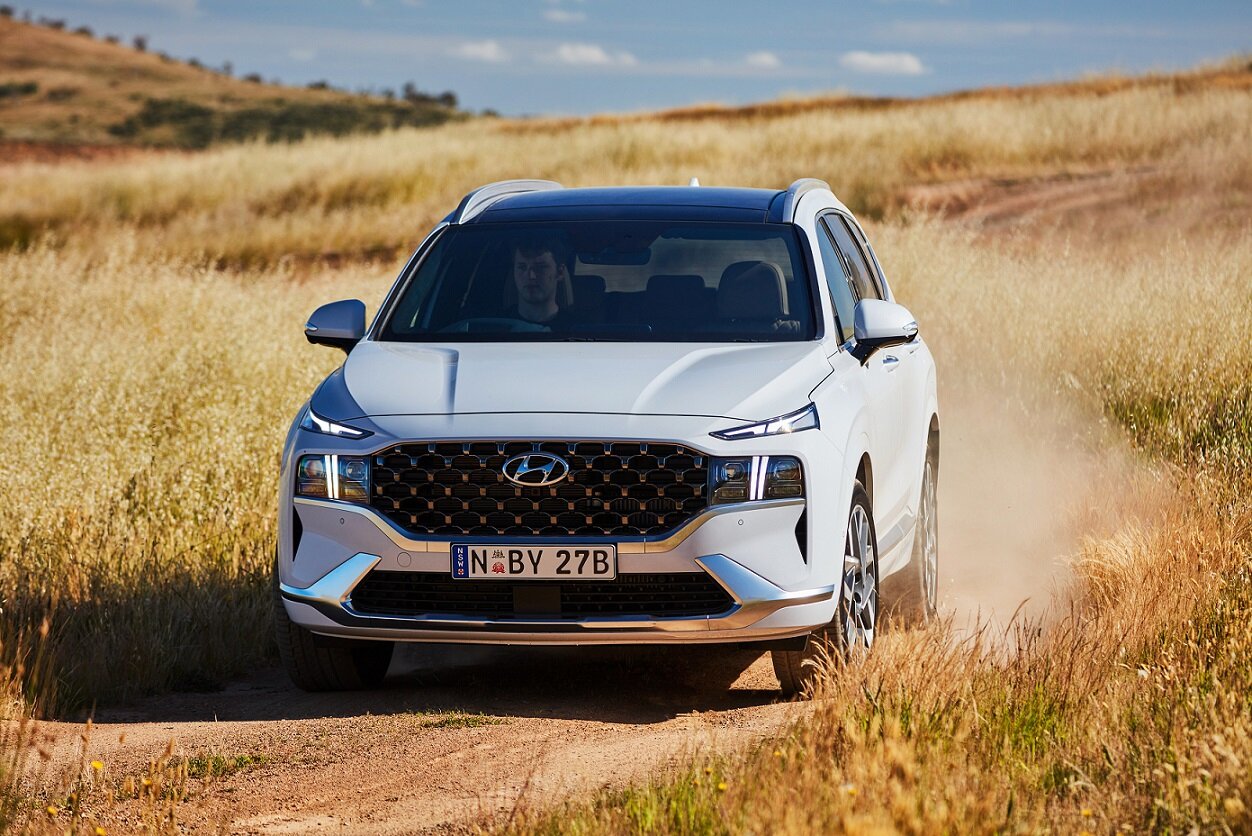

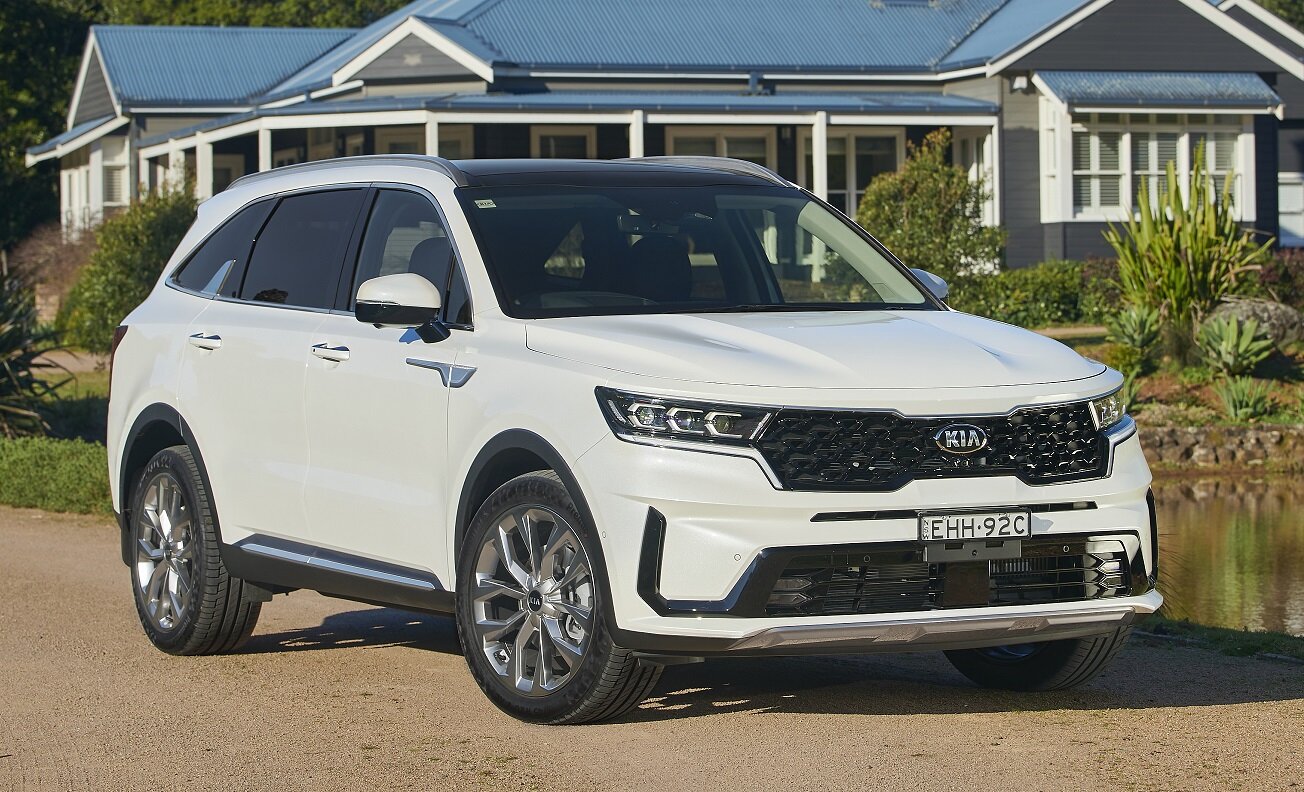
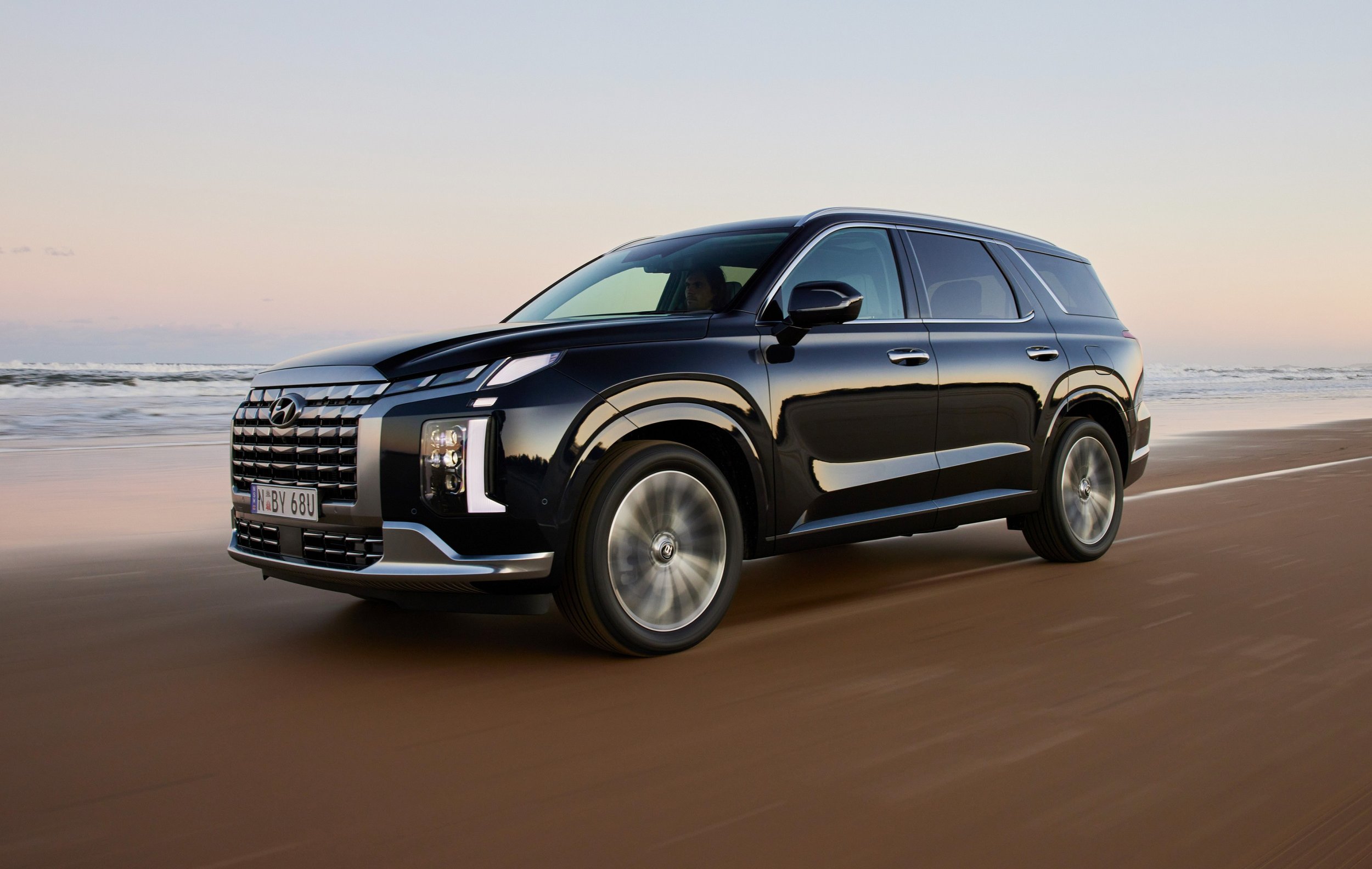
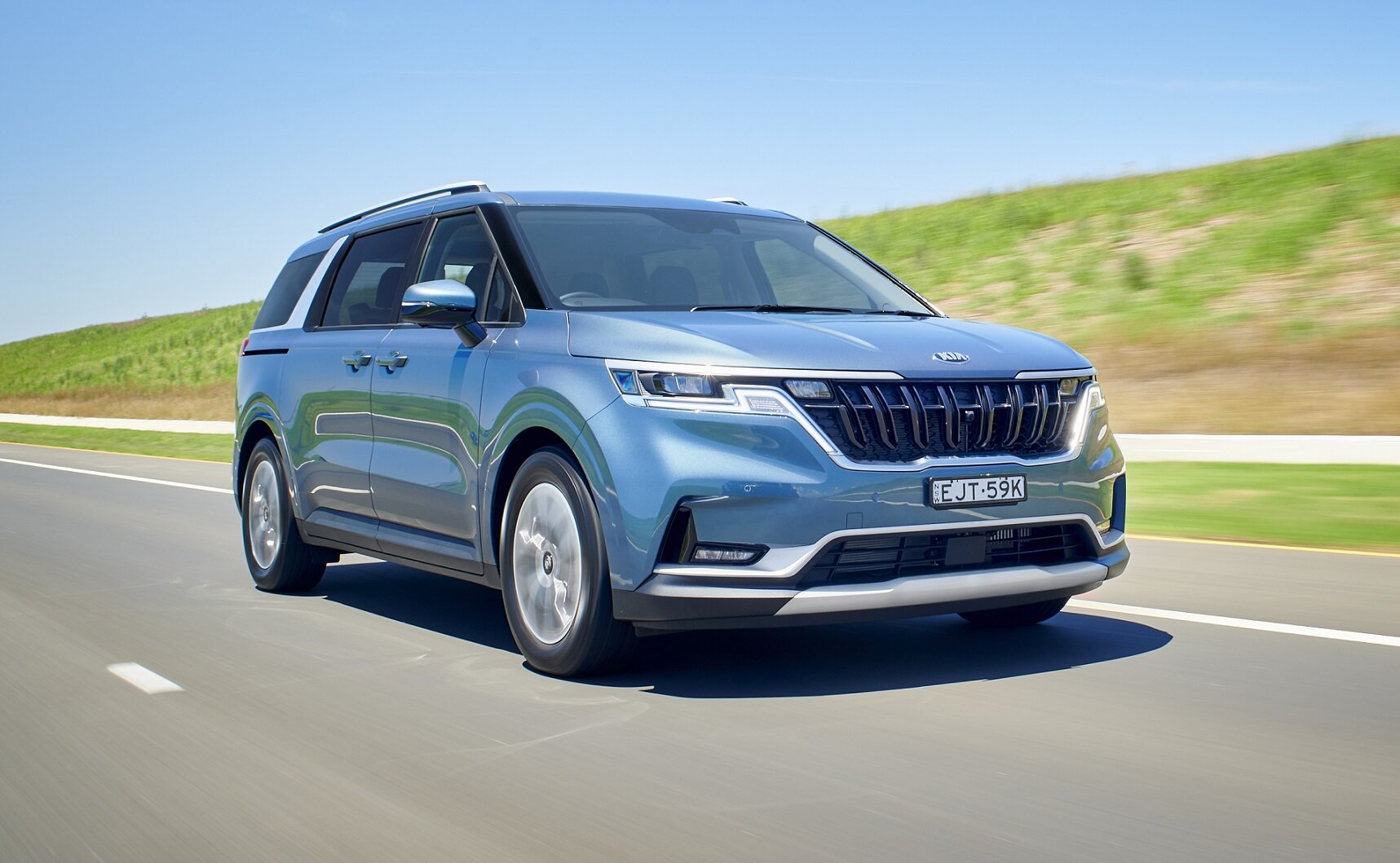
Hyundai Santa Fe: Eight-speed dual-clutch transmission drives very smoothly; full-size spare offers normal operation when in-use; styling subjectively more interesting; active AWD system responds quickly; diesel Highlander for $72K; 30kg lighter; 13 litres more row-3-down cargo space; braked 2500kg towing capacity (200kg towball d/load); available as hybrid now; front centre airbag; safe exit warning/assist. Hyundai Santa Fe: Full Australian Buyer's Guide >>
Mitsubishi Outlander: Base 7-seat version is cheap at $44K; top-spec Exceed Tourer ~$15K cheaper than CX-8 Asaki; option of a plug-in hybrid with EV mode; 10-year warranty (when serviced exclusively with Mitsubishi dealers); driver’s knee airbag; front centre airbag. Mitsubishi Outlander review & buyer's guide >>
Kia Sorento: Rotary transmission selector; single row-3 ISOFIX point; full-size spare wheel; 2000kg towing (200kg towball d/load); available as plug-in hybrid; Australian-specific suspension & handling tuning; touchscreen infotainment; looks distinguishable from Sportage, Seltos etc.; front centre airbag; reclining row 2 seats; safe exit warning/assist. Kia Sorento review and buyer's guide >>
Hyundai Palisade: Available as 8-seater; enormous boot (1297 L max / 311 L min); braked 2200kg towing capacity (200kg towball d/load); touchscreen infotainment system; slightly higher ground clearance (3mm); full-size spare wheel; better 360-degree camera; better cabin storage; front centre airbag; safe exit warning/assist. Hyundai Palisade: Full Review for Real Buyers in Australia >>
Kia Carnival: Full-time 8-seater for adults; Eight-speed dual-clutch transmission; removeable row-2 centre seat allows walk-through access to row 3; quasi-van mode for large bulky items (rows 2 & 3 collapsed); 2000kg towing (200kg towball d/load); large tailgate acts as shade/rain awning; sliding row 2 access doors; Australian-specific suspension & handling tuning; driver knee airbag; row 3 curtain airbags; safe exit warning/assist. Hyundai Santa Fe: Full Australian Buyer's Guide >>
CONCLUSION:
WHICH CX-8 SHOULD YOU BUY?
Without doubt, the best value for money (pending your budget elasticity, once again) the front-wheel drive Asaki is $65,700 which gets you all the toys, the nice seats, all the higher-end luxuries - but you’ll save over $7000 by avoiding the AWD version.
To be fair, if you live in an urban environment, you don’t strictly need all-wheel drive. So that immediately saves your several thousands depending on which grade of CX-8 you might ultimately buy. AWD does give you slightly better grip when accelerating from stationary with generous throttle applications, but after that, it’s basically just a conversation of motion - keeping the wheels turning and the vehicle’s kinetic energy up. Grip no longer becomes a critical aspect of mundane routine driving.
And we have stability and traction controls (among other clever safety features) designed to keep you pointing straight on all four wheels. Even when you swerve in an emergency, these systems will save your life and that of whatever you’re trying to avoid. So AWD is not as important as you might be led the believe. Having said that, it does have its uses - you just need to figure out how many sketchy dirt roads or wet grassy or muddy carparks you’re likely to visit.
Beyond that, the diesel CX-8 is the ideal engine for this kind of vehicle designed to carry loads of people and get loaded up for school holidays and the inevitable roadtrips. The petrol engine is fine, but the diesel will return better fuel economy and is much smoother.
In terms of balancing price, features and powertrain, I’d suggest you consider something like a front-drive GT or Asaki at $62K - $65K, or an AWD Touring or GT - this keeps you around that low-to-mid $60K where you still get the premium sound system in GT, or most of the convenient toys in Touring like leather, rear sensors and push-button entry. Saves you fumbling around for the key fob.
With a rear camera standard in most cars these days, and using your mirrors, the extra cash you’d spend for the 360 camera in the Asaki doesn’t really seem worth it - but it might if you want ventilated/cooled seats, which admittedly, can be bloody nice in summer. This all depends on your budget, which is why a FWD Asaki is a good compromise to have the seat cooling, 360 camera and the sexy Nappa leather, but without paying another $8000 just to have AWD you probably don’t need.
The overall advantage of a CX-8 over its CX-9 stablemate, or even the seriously popular big SUVs from Hyundai and Kia, is that Mazda’s product is very strong right now in terms of the prestige and polish, but CX-8 offers that slightly smaller footprint than the CX-9. What you sacrifice in cubic cargo space, is also a serious saving in cash, which still getting a high quality, reliable, comfortable seven-seater that can do all the same work as the competition, but keeps that little bit of additional cash in your account.
CX-8 has proven itself quite popular in terms of Australian sales, even at times outselling the competition (Hyundai Santa Fe 4135, year to Nov 2022 | Palisade: 3756 | CX-8: 5397). It also outsold the CX-9 in November 2022, 492 to 386. CX-8 should finish 2022 with just under 6000 units sold, compared with about 800-1000 more CX-9s.
All this should prove to you, as someone preparing to spend their own money, is that sometimes bigger isn’t always necessarily better.





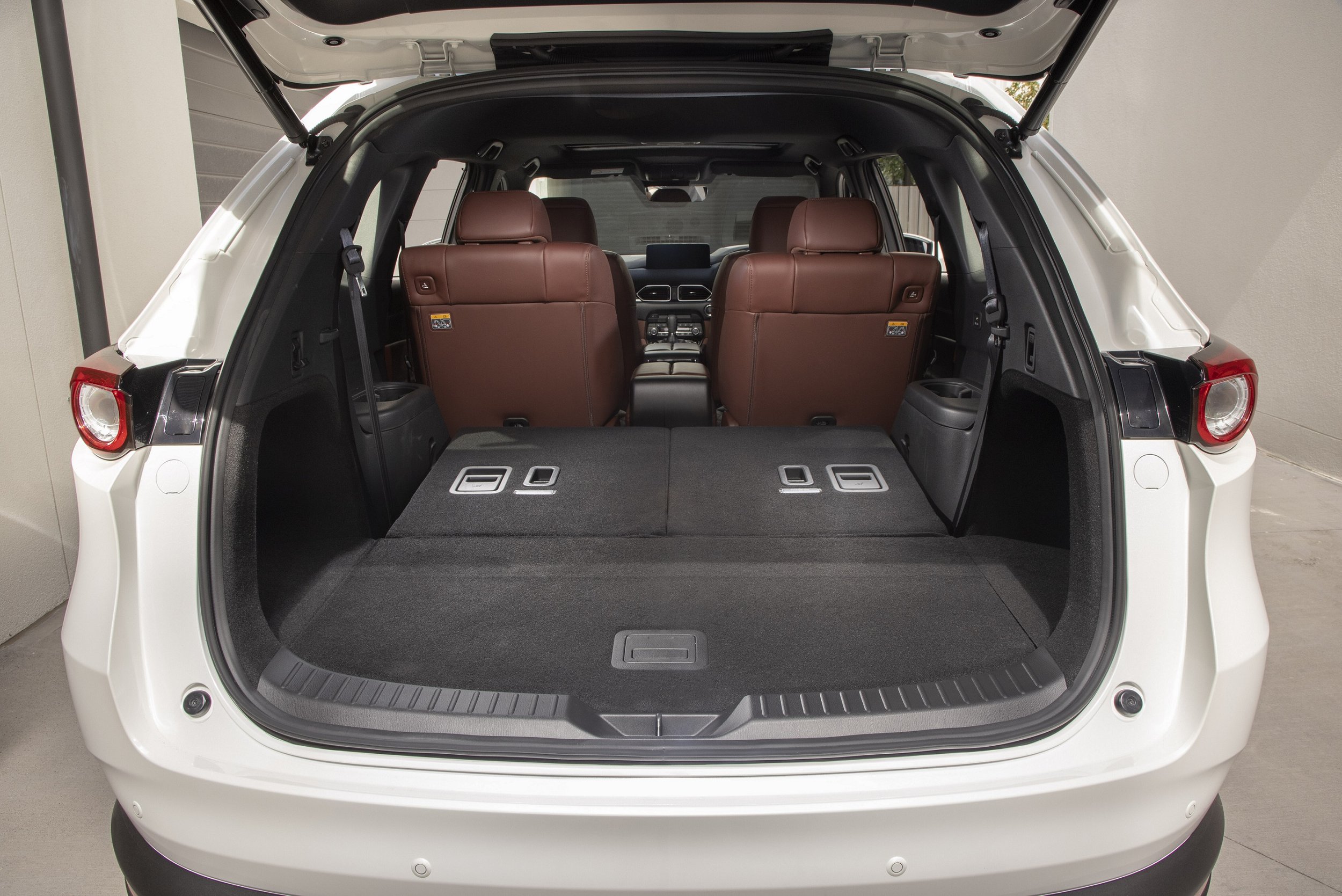

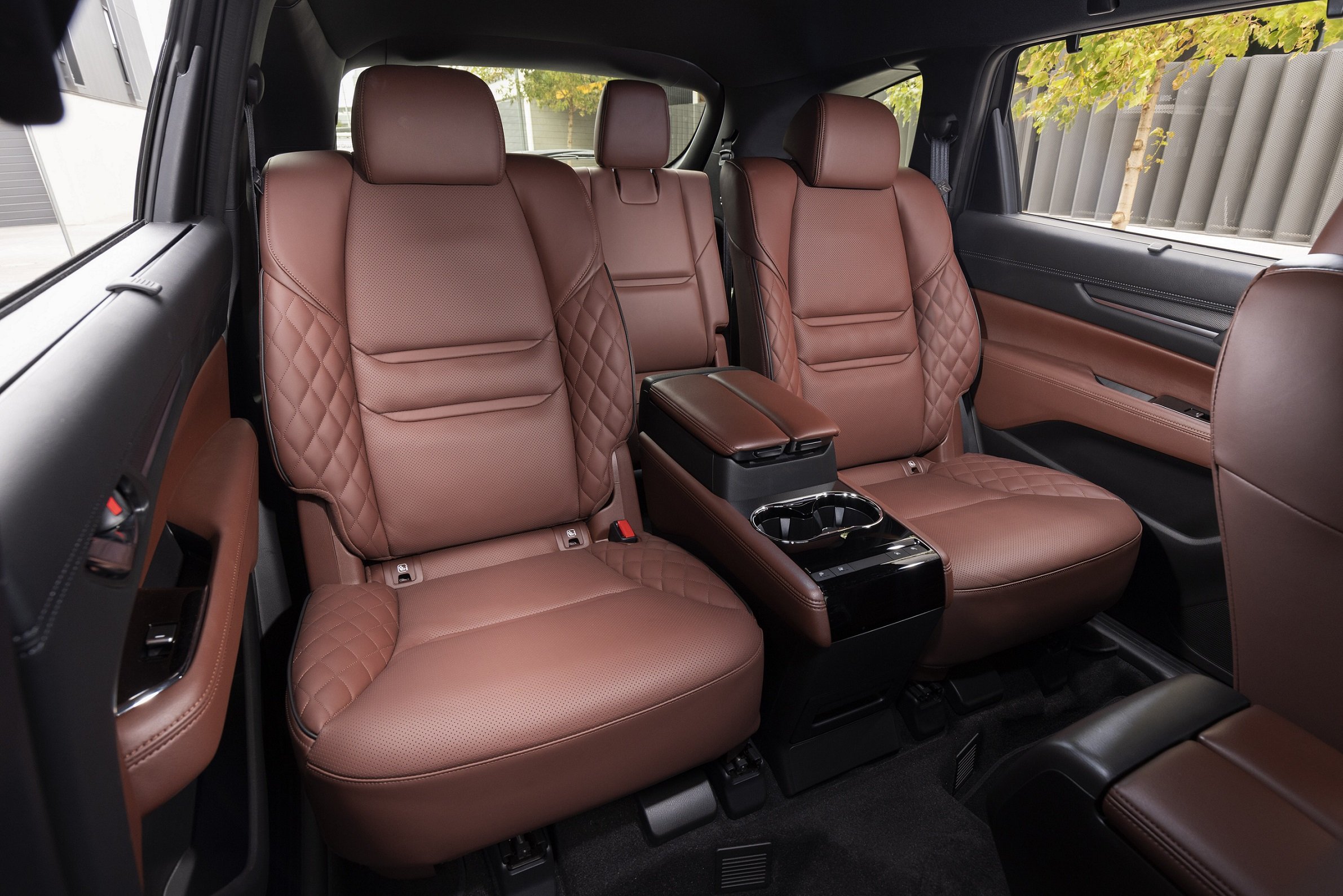




















A Kia Stonic is the next big thing in SUVs if you’re looking for modest size but with all the benefits of a normal hatchback. It’s safe, economical and affordable, making it an ideal first car.